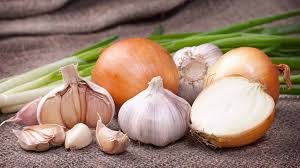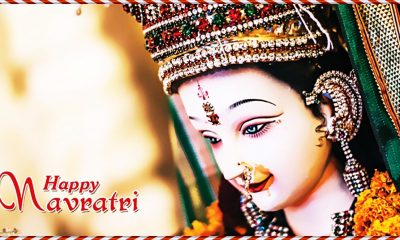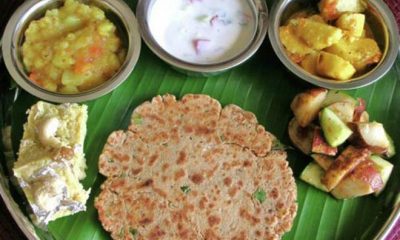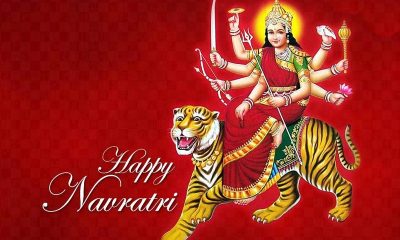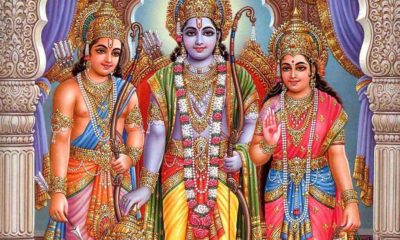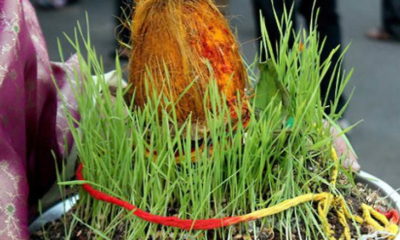Feature
Why Is It Forbidden To Eat Onions And Garlic During The Navratri festival
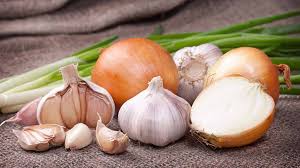
Lucknow : The season of festivals is here and there is a lot of excitement in the air. The first in the line-up of festivals is Navratri which began on 21st September 2017 and will go on for 9 days till 29th September 2017 . It is celebrated in the holy month of Ashwin, and is also known as Maha Navaratri. Devotees worship the nine forms of Durga also called the Nav Durga during this period with plenty of offerings and bhog and observe special fasts to seek her blessings.
It is believed that during these 9 days, Goddess Durga descends from the heavens above and takes shelter amongst her devotees to bless them with strength, power and prosperity. During the Navratri fasts, people follow a strict vegetarian diet and refrain from consuming certain foods like cereals, grains, non-vegetarian food, regular salt and alcohol. They prepare their daily meals with vrat ingredients like Singhara atta, buckwheat flour, sabudana,fresh fruits, sendha namak and samak ke chaawal. If you happen to observe these ritualistic fasts, or know someone who is keeping them, you may know of the practice of not including onions and garlic in the special Vrat ka Khana or fasting meal. In fact, people who do not observe these fasts also refrain from consuming onion, garlic, non-vegetarian food and alcohol during the nine days of Navratri
But, do you know why you are told to avoid onion and garlic even though they are categorised as vegetarian foods?
According to Hindu and ancient Ayurvedic understanding, foods can be divided into three categories, depending upon their nature and the response they trigger in the body after consumption. These three categories are as follows.
1.Raajasic food
2.Taamasic food
3.Saatvik food
The word Saatvik comes from the word, Sattva – which means the one that is pure, natural, vital, energetic, clean and conscious. Saatvik foods include most of your vrat ingredients like fresh fruits, cooling curd, pure rock salt, seasonal vegetables like pumpkin and lauki and subtle spices like cumin, coriander and black pepper. On the other hand, the words ‘Rajas’ and ‘Tamas’ refer to something that is destructive, resentful, unripe and weak.
While fasting for Navratri, people opt to go for saatvik food. Besides the religious aspect, there is a scientific reason for this too. Sharad Navratri falls around the months of October-November which usually mark the transition period from autumn to winter. During this time of seasonal change, our immunity tends to decline and therefore, it helps to switch to light saatvik food that does not burden your digestive system. It may also help in keeping away from toxins that may breed in greasy, heavy or unhealthy food, and thus, cleanses your body of all impurities.
Onion and garlic are categorized as Taamasic in nature, and have been linked to invoke carnal energies in the body. Onions are also said to produce heat in the body. Therefore, they are avoided during the Navratri fasts..
Ancient Vedic texts also regard salty, spicy, strong and pungent foods to take away one’s focus from the devotion of the Lord.
Entertainment
Meghalaya Reserves Legalized Gambling and Sports Betting for Tourists

The State Scores Extra High on Gaming-Friendly Industry Index
Meghalaya scored 92.85 out of 100 possible points in a Gaming Industry Index and proved to be India’s most gaming-friendly state following its recent profound legislation changes over the field allowing land-based and online gaming, including games of chance, under a licensing regime.
The index by the UK India Business Council (UKIBC) uses a scale of 0 to 100 to measure the level of legalisation on gambling and betting achieved by a state based on the scores over a set of seven different games – lottery, horse racing, betting on sports, poker, rummy, casino and fantasy sports
Starting from February last year, Meghalaya became the third state in India’s northeast to legalise gambling and betting after Sikkim and Nagaland. After consultations with the UKIBC, the state proceeded with the adoption of the Meghalaya Regulation of Gaming Act, 2021 and the nullification of the Meghalaya Prevention of Gambling Act, 1970. Subsequently in December, the Meghalaya Regulation of Gaming Rules, 2021 were notified and came into force.
All for the Tourists
The move to legalise and license various forms of offline and online betting and gambling in Meghalaya is aimed at boosting tourism and creating jobs, and altogether raising taxation revenues for the northeastern state. At the same time, the opportunities to bet and gamble legally will be reserved only for tourists and visitors.
“We came out with a Gaming Act and subsequently framed the Regulation of Gaming Rules, 2021. The government will accordingly issue licenses to operate games of skill and chance, both online and offline,” said James P. K. Sangma, Meghalaya State Law and Taxation Minister speaking in the capital city of Shillong. “But the legalized gambling and gaming will only be for tourists and not residents of Meghalaya,” he continued.
To be allowed to play, tourists and people visiting the state for work or business purposes will have to prove their non-resident status by presenting appropriate documents, in a process similar to a bank KYC (Know Your Customer) procedure.
Meghalaya Reaches Out to a Vast Market
With 140 millions of people in India estimated to bet regularly on sports, and a total of 370 million desi bettors around prominent sporting events, as per data from one of the latest reports by Esse N Videri, Meghalaya is set to reach out and take a piece of a vast market.
Estimates on the financial value of India’s sports betting market, combined across all types of offline channels and online sports and cricket predictions and betting platforms, speak about amounts between $130 and $150 billion (roughly between ₹9.7 and ₹11.5 lakh crore).
Andhra Pradesh, Telangana and Delhi are shown to deliver the highest number of bettors and Meghalaya can count on substantial tourists flow from their betting circles. The sports betting communities of Karnataka, Maharashtra, Uttar Pradesh and Haryana are also not to be underestimated.
Among the sports, cricket is most popular, registering 68 percent of the total bet count analyzed by Esse N Videri. Football takes second position with 11 percent of the bets, followed by betting on FIFA at 7 percent and on eCricket at 5 percent. The last position in the Top 5 of popular sports for betting in India is taken by tennis with 3 percent of the bet count.
Local Citizens will Still have Their Teer Betting
Meghalaya residents will still be permitted to participate in teer betting over arrow-shooting results. Teer is a traditional method of gambling, somewhat similar to a lottery draw, and held under the rules of the Meghalaya Regulation of the Game of Arrow Shooting and the Sale of Teer Tickets Act, 2018.
Teer includes bettors wagering on the number of arrows that reach the target which is placed about 50 meters away from a team of 20 archers positioned in a semicircle.
The archers shoot volleys of arrows at the target for ten minutes, and players place their bets choosing a number between 0 and 99 trying to guess the last two digits of the number of arrows that successfully pierce the target.
If, for example, the number of hits is 256, anyone who has bet on 56 wins an amount eight times bigger than their wager.

